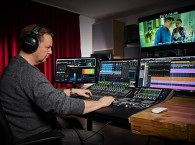
When it comes to mixing for immersive audio formats, and in particular for Dolby Atmos music, the pressure to deliver results as quickly as with established stereo production and mastering methods becomes overwhelming. The resource is to use binaural rendering software and mix over headphones, checking and fine tuning the mix in an actual studio at a later stage.
Based at the University of Huddersfield in the UK, Applied Psychoacoustics Laboratory (APL) was founded in 2013 by renowned spatial audio and psychoacoustic engineering expert, Professor Hyunkook Lee. The project's mission was to push the boundaries of sound technology, focusing on the intersection of psychoacoustics and immersive audio. Today, APL employs a multidisciplinary team of psychoacoustics researchers, digital audio signal processing engineers, sound engineers and music producers and although it already sells its software, it remains an academic research project.
Originally launched in May of 2023, APL Virtuoso is a culmination of over 10 years of research into binaural audio and spatial sound, offering users the ability to mix and monitor immersive audio over headphones, without the need for complex loudspeaker setups. The ASPEN (APL Spatial Audio Engine) is the core technology developed by the research team, providing advanced virtual acoustic simulation. APL claims its Virtuoso software is "the most realistic and natural-sounding binaural renderer" able to transform headphones into a world-class studio.

Now, APL introduced Virtuoso v2, a software update that includes newly developed features that further advance what is possible from binaural rendering technology. The updated software now offers acoustic emulation, with customizable virtual listening rooms that mimic real environments. And Virtuoso v2 now delivers accurate externalization and localization of sound, ensuring mix decisions translate well to loudspeakers, while simulating the experience of listening to loudspeakers in a perfectly tuned room.
Key features include support for 53 speaker configurations (from mono to Dolby Atmos and Auro-3D), seven virtual room presets, fully customizable acoustic settings, and built-in HRTF and head tracking. The software currently provides EQ compensation for 100 headphone models, ensuring improved response accuracy across any setup.
HRTF (Head-Related Transfer Function) settings in APL Virtuoso allow users to choose one of the five built-in presets, or upload their own personalized HRTF files for an even more realistic adjustment. By adjusting HRTF and virtual room acoustic settings, the software accurately simulates how sound would naturally be perceived in a physical space, providing realistic spatial cues. This allows users to experience audio that feels externalized, as if coming from around them, rather than from within their headphones. This precise spatial representation is key to reducing ear fatigue and delivering a highly authentic and natural listening environment.

Virtuoso v2 also 10-band parametric EQ for headphone equalization, and the ability to load built-in or custom EQ profiles. The standalone version of Virtuoso v2 now has a built-in WAV/ADM player so users can cue up their favorite music in stereo or multichannel format, or Dolby Atmos ADM master files for easy listening. With a newly developed 3D interactive user interface, it's easier to visualize each speaker arrangement and customize their settings more intuitively. This multichannel WAV/ADM player is useful not only for checking how a stereo or immersive mix would translate in various playback environments, it is also a useful quality control tool when working remotely with a client. This has already become one of the main use cases of Virtuoso at music and post-production studios.
With the release of Virtuoso v2, APL also introduced an integration with the Audeze Maxwell headphones, which feature head-tracking. Unlike traditional head-trackers, which typically require wired connections and additional bridge software, the Audeze headphones are completely wireless. Virtuoso v2 reads the Maxwell's tracking data directly, eliminating the need for complicated setups. This integration allows users to experience more realistic binaural audio effortlessly, making spatial audio mixing and immersive listening simpler and more precise than ever before.

World-renowned mastering Bob Katz uses this software, and praises the results stating "We finally have a translation tool that allows mixing with headphones," and adds, "Using Virtuoso, I got a sense of height and rear localization which is far better than other binaural systems I have tried."
Apart from an AAX, VST3 and AU plug-in, the APL Virtuoso v2 software is available as standalone application, opening up the potential uses and providing a level of flexibility not yet seen in this area. Plugins are available for USD $199 and the standalone app for $149 (macOS and Windows). There's also a bundle for USD $299 (plugins and standalone). APL is offering a 50% discount on all three versions for a limited time.
www.apl-hud.com







